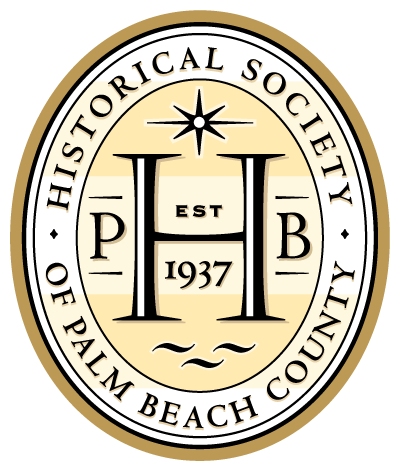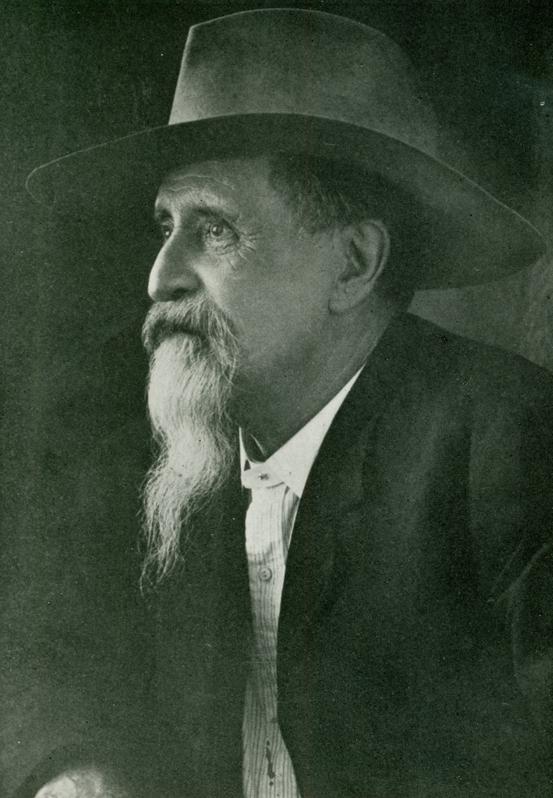
by Debi Murray
Ed. Note: This article by current Chief Curator Debi Murray was first published in Tustenegee in 2010, documenting an exciting historical discovery. It is lightly edited for online publication.
One good thing about history is that it is not static. A single little clue can lead to a completely new view of the past. Just such a clue and a series of serendipitous circumstances led to a new entry in the chronology of post offices in what is now Palm Beach County. It all started with the receipt of a stack of photocopies a gentleman had collected over the years. He loved history and made it his mission to transcribe primary documents from various sources, which he typed out for his own reference. A quick glance revealed that some of the sources were already held by the Historical Society, but deeper reading revealed much more, especially the meeting minutes and articles collected from and about the organization of local pioneers.

The Lake Worth Pioneer’s Association (LWPA) was founded in 1904. At the time, the Tropical Sun, the area’s first newspaper, published an appeal for the creation of an association that would keep “in mind of old times and the correction and perfection of old time records and the preservation of same.” The paper’s editor, George Rowley, wrote that “the old time history of this section is both interesting and instructive.” Elisha Newton Dimick agreed and placed an advertisement in state newspapers asking “old settlers” who had been living in the “Lake Worth section before January 1, 1890” to attend an organizational meeting at the Free Reading Room in West Palm Beach. At that meeting the attendees agreed to move the cut-off date for official pioneer status to January 1, 1893.
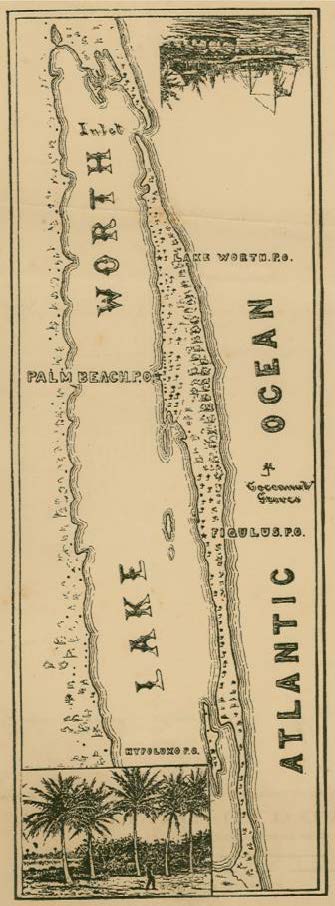
The compilation of meeting minutes and newspaper articles details the first Pioneer Picnic, which was held at Munyon’s Island on the veranda of the Hygeia Hotel on July 4, 1904, about two weeks after the group’s founding. The seventy-three attendees included “old settlers, wives, and children . . . not too big a crowd for comfort and yet big enough to have lots of fun.” The day included full hampers of food and plenty of music. By the end of July, the officers of the group had created a “Historical and Revision Committee,” which was directed to collect materials, “dates[,] and data” from all the pioneers, “regardless of sex,” as the committee wanted “to hear from the ladies as well as the gentlemen who were here in the early days.”
In subsequent meetings, the association members reported what they had collected, such as the biographical information on William Jenkins Worth, for whom Lake Worth was named, and what they were still looking for, including the “log” of __ Charles Moore. With their ultimate goal to write a comprehensive pioneer history, the committee also wrote various federal and state government agencies requesting detailed information about early surveys, maps, railroads, canals, agricultural information, and post offices.
The most interesting comment mentioned the early postal route from St. Lucie and the first post offices. Numerous reports had arrived from a variety of U.S. Post Office departments in Washington, DC, and in the meeting minutes, secretary George Rowley wrote parenthetically that “[i]t was found that the first Post Office—TUSKINEEGEE—had been omitted.” This was the first time I had ever heard of anything other than Lake Worth as the first post office on the lake. The same day I read this, I had occasion to visit the Preservation Foundation of Palm Beach, where they were setting up a map exhibit. To my immense surprise, the very first map I examined showed Tustenegee on Lake Worth. Although a different spelling than in the meeting minutes, it was close enough and merited further investigation.
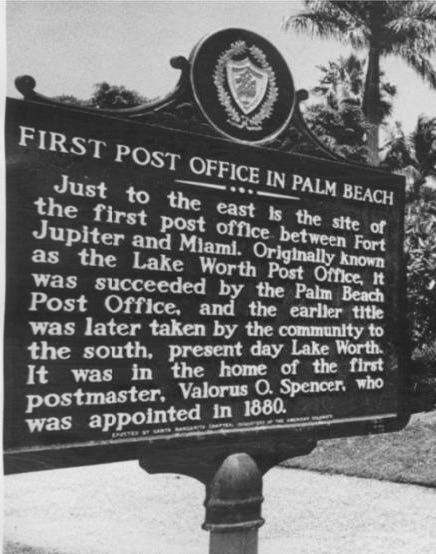
After Hurricane Frances hit in 2004, the Historical Society offices were closed due to damage in the Paramount Building. For a time, it looked like Hurricane Ivan was going to hit us as well, so I decided some time in Washington, DC, would offer a break from lack of electricity and a place to work, as well as a chance to conduct research in the National Archives. I spent my time there looking through rolls of microfilm and boxes of original documents relating to the people, places, and events of our local history, especially our postal past. Almost immediately I found the microfilm roll containing the list of Dade County (as we were then) post offices. The first was Biscayne, the second Maama (later known as Miami), and the third was Tustenegee. What locals had always claimed as the first on Lake Worth was listed fifth, after the entry for Miami. This listing of post offices also included dates and the names of postmasters. Tustenegee was established February 27, 1877, with James B. Brown the postmaster. It was discontinued in October and re-established the following month with Albert Geer as postmaster. Its final demise was March 11, 1879. This simple listing raised even more questions than finding the name in the LWPA’s minutes initially.
First of all, who was James B. Brown? He is not mentioned in Charles Pierce’s manuscript, nor in the resulting book, Pioneer Life in Southeast Florida, as edited by Donald Curl, an excellent account of pioneer life on Lake Worth. He is not listed in the 1870 or 1880 censuses for this area, so he must have arrived and departed in the years between. He did not homestead in the area, as he is not listed in the Florida land records. Cursory research on Ancestry.com lists far too many James B. Browns to spend further time there. A real mystery man.
On the other hand, there is quite a lot of information about Albert Geer available in the Historical Society archives and in secondary sources. Albert; his wife, Marion; their son, Everard; and their extended family arrived on the shores of Lake Worth in 1876. Albert had two sisters, Anna and Ella, who had married brothers Frank and Elisha Dimick. Frank and Anna had three children, and Elisha and Ella had one child; they made the trek to south Florida with them. The Dimicks’ parents, Moore and Parthenia, also traveled south with the party.
Twenty years later, Marion wrote a memoir in which she related their life on the lake. She wrote of building their house, planting crops and tropical trees, and the feeling of being cut off from the rest of the world because of the lack of postal service. The closest post office to the north was St. Lucie, sixty-five miles away, and seventy-five miles south was Miami, then officially called “Maama,” but there was no carrier service between the two. Although Marion does not offer a name or an exact year, there was a post office on Lake Worth “after a residence of two years.” But again, there was “no carrier until after the election of Noble A. Hull to Congress.” Hull was elected to the U.S. House of Representatives in November 1878 and seated the following March. Since the post office named Lake Worth was not established until May 31, 1880, Marion must have been referring to Tustenegee.
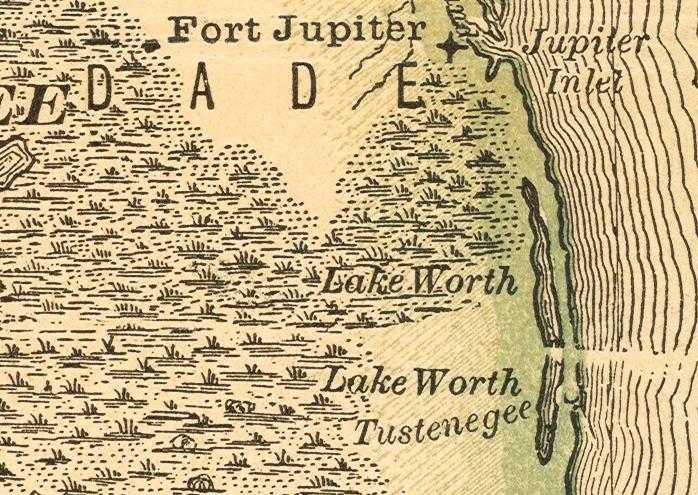
Frustratingly, Marion never mentions James B. Brown or her husband as the postmasters, although with her husband in charge, the post office would have been in their own house. As postmaster, Geer would have been earning something from the postage he sold. In her memoir, Marion detailed some of the creative ways they worked to generate a cash income. Since she did not report any income from the post office, the money from that source must have been minimal at best.
The closest we can get to a second supporting source for Albert Geer as a postmaster (so far) is in his obituary. Albert, Marion, and their two sons (Levy was born in late 1879 or early 1880) moved to Union City, Michigan, in 1886, so the children could attend school. Albert died there on March 20, 1926. His obituary named him as the first postmaster on Lake Worth. While this fails to mention James B. Brown, it is possible that Levy, with whom Albert was living at the time of his death, had never heard of Mr. Brown, who had moved away long before Levy’s birth.
The final question about the forgotten post office was its name—Tustenegee. Close variations of this word can be found in several books about the Seminoles. Several Seminole leaders used Tustenugee as part of their name. Another close sounding word was spelled tus-ka-nuk-kee. Both words have their root in the Creek word tàstànàgi, which translates to “warrior.” Did the local Seminoles call James B. Brown Warrior? Or did Brown know a Seminole called Tustenegee (however it may have been spelled)? We will perhaps never know.
The search to learn more about Tustenegee is not over. There are document boxes in the National Archives in Washington, DC, full of post office applications. I started to go through them in 2004 but ran out of time. These forms provide the name of the office, the postmaster applying, and hand-drawn maps showing exactly where the new office would be in relation to others in the area. I made copies of the applications for local offices that I could find, but there are more to be unearthed. In addition, there may be other sources available. Any clue could lead the way to more information.
Compiled from the Geer Family file; Post Office File in the HSPBC archive.
Printed Sources:
Cory, C.B. Hunting and Fishing in Florida. Boston, MA: The Barta Press, 1896.
Read, William A. Florida Place Names of Indian Origin and Seminole Personal Names. Tuscaloosa, AL: University of Alabama Press, 2004.
Robinson, Tim. A Tropical Frontier: Pioneers and Settlers of Southeast Florida, 1800-1890. Port Salerno, FL: Port Sun Publishing, 2005.
Historical Society of Palm Beach County
You might also enjoy
A Celebration of Pride
Celebrating the Legacy and Resilience of H.G. Roosters June 1,
Black Cultural Heritage Trail
Learn of the Rich Cultural Heritage of Palm Beach County
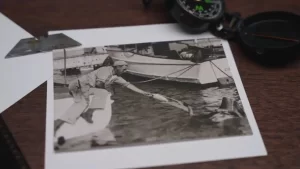
The Conchtown Rumrunners
The Conchtown Rumrunners Behind the Palms, Episode 2 Volstead Act

